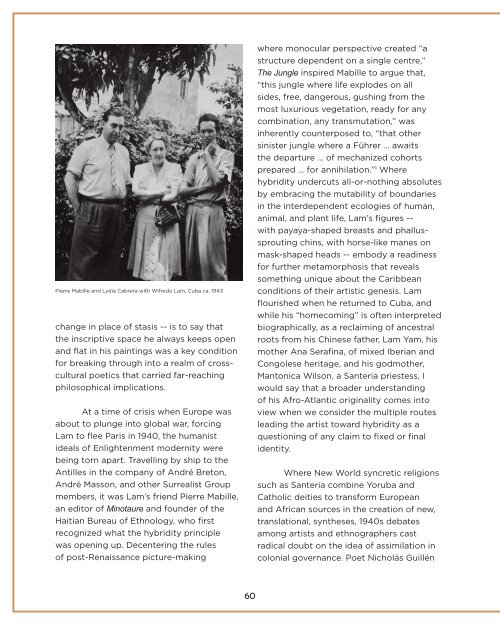Kobena Mercer – Wifredo Lam’s Cross-Cultural Rhizomes
Excerpt from “Lam/Basquiat”, a catalog published by Galerie Gmurzynska on the occasion of a special presentation at Art Basel 2015, prepared in collaboration with Annina Nosei.
Excerpt from “Lam/Basquiat”, a catalog published by Galerie Gmurzynska on the occasion of a special presentation at Art Basel 2015, prepared in collaboration with Annina Nosei.
Create successful ePaper yourself
Turn your PDF publications into a flip-book with our unique Google optimized e-Paper software.
Pierre Mabille and Lydia Cabrera with Wifredo Lam, Cuba ca. 1943<br />
change in place of stasis -- is to say that<br />
the inscriptive space he always keeps open<br />
and flat in his paintings was a key condition<br />
for breaking through into a realm of crosscultural<br />
poetics that carried far-reaching<br />
philosophical implications.<br />
At a time of crisis when Europe was<br />
about to plunge into global war, forcing<br />
Lam to flee Paris in 1940, the humanist<br />
ideals of Enlightenment modernity were<br />
being torn apart. Travelling by ship to the<br />
Antilles in the company of André Breton,<br />
André Masson, and other Surrealist Group<br />
members, it was <strong>Lam’s</strong> friend Pierre Mabille,<br />
an editor of Minotaure and founder of the<br />
Haitian Bureau of Ethnology, who first<br />
recognized what the hybridity principle<br />
was opening up. Decentering the rules<br />
of post-Renaissance picture-making<br />
where monocular perspective created “a<br />
structure dependent on a single centre,”<br />
The Jungle inspired Mabille to argue that,<br />
“this jungle where life explodes on all<br />
sides, free, dangerous, gushing from the<br />
most luxurious vegetation, ready for any<br />
combination, any transmutation,” was<br />
inherently counterposed to, “that other<br />
sinister jungle where a Führer … awaits<br />
the departure … of mechanized cohorts<br />
prepared … for annihilation.” 1 Where<br />
hybridity undercuts all-or-nothing absolutes<br />
by embracing the mutability of boundaries<br />
in the interdependent ecologies of human,<br />
animal, and plant life, <strong>Lam’s</strong> figures --<br />
with payaya-shaped breasts and phallussprouting<br />
chins, with horse-like manes on<br />
mask-shaped heads -- embody a readiness<br />
for further metamorphosis that reveals<br />
something unique about the Caribbean<br />
conditions of their artistic genesis. Lam<br />
flourished when he returned to Cuba, and<br />
while his “homecoming” is often interpreted<br />
biographically, as a reclaiming of ancestral<br />
roots from his Chinese father, Lam Yam, his<br />
mother Ana Serafina, of mixed Iberian and<br />
Congolese heritage, and his godmother,<br />
Mantonica Wilson, a Santeria priestess, I<br />
would say that a broader understanding<br />
of his Afro-Atlantic originality comes into<br />
view when we consider the multiple routes<br />
leading the artist toward hybridity as a<br />
questioning of any claim to fixed or final<br />
identity.<br />
Where New World syncretic religions<br />
such as Santeria combine Yoruba and<br />
Catholic deities to transform European<br />
and African sources in the creation of new,<br />
translational, syntheses, 1940s debates<br />
among artists and ethnographers cast<br />
radical doubt on the idea of assimilation in<br />
colonial governance. Poet Nicholás Guillén<br />
60
















